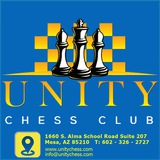Unity Chess Club
Ma Qun-Daryl Johansen Canberra 2018 How should White continue?
22.♗xe5! dxe5 23.♗c4 ♕c7
Black gives up a pawn, instead of accepting utter passivity after 23…♖f8 24.♖hf1 ♗f6, when the difference in strength between the opposite-colored bishops is obvious. After 25.♕b5, White will follow up with ♖d1-d7, and have a big, big advantage.
White has to defend the c2-pawn, but the bishop was active again nine moves later, while Black had dropped the a4-pawn, too:
25…♖f8 26.♕c4 ♕b6 27.♕b5 ♕c7 28.♖hf1 ♗f6 29.♗e2 ♖fc8 30.c3 ♖d8 31.♖xd8+ ♖xd8 32.♖d1 h6 33.♕xa4 ♔h7 34.♗g4 ♖xd1+ 35.♕xd1 ♕b6 36.♔a2 g6 37.♕d5 ♗g7 38.♗c8 ♕f2 39.♕xb7 ♕xg2 40.♗e6 h5 41.a4 1-0
White increases his space advantage, which results from his central passed pawn, and intends to drive the black pieces further back.
